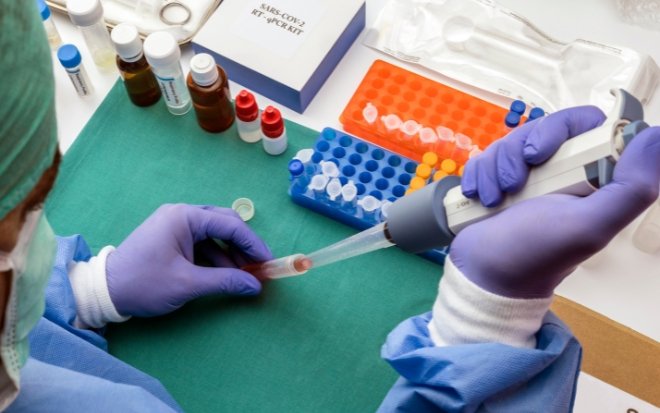Major Point From Hospital
- FNAC
- Trucut Biopsy
- Immuno Histo Chemistry
- Tumor Markers
- Fibre Optic Endoscopies
- Flow Cytrometry
- Gene Mutational Studies
- X-Ray
- Haematology Including Bone Marrow Biopsy
Here are some key aspects of oncological rehabilitation:
1. Haemotology including bone marrow biopsy
The Department of Haematology at Krishna Cancer Hospital provides integrated, patient-centric
and extensive services for early detection and management of all sorts of blood disorders in
children and adults, including blood cancer.
Backed by the best haematologists in Bhopal Madhya Pradesh, the haematology department strives
to be one of the most sought-after treatment centres for diagnosis and treatment of benign and
malignant disorders of haematology. Besides, we offer separate blood transfusion and laboratory
haematological services for quick detection of symptoms and signs of haematological disorders.
Our department of haematology is often at the forefront of existing and advanced techniques of
haematology services, making our facilities dynamic, self-reliant and efficient for all
patients.
Our highly specialised multidisciplinary team of the best haematologists in Bhopal comprises
paediatric haematologists and adult haemato-oncologists offering superior treatment to complex
blood disorders. Moreover, we are on constant quest to adapt advanced techniques for providing
superlative clinical quality to our treatment procedures.
Our high standards of treatment and patient care services are the priority of our entire staff.
Even the support services are given priority to ensure that patients don’t face any trouble.
This is what makes our treatment centre highly steadfast and a reliable place for patients
suffering from different types of blood disorders.
2. FNAC
Fine needle aspiration cytology (FNAC) is a minimally invasive procedure used to collect cell
samples from suspicious masses for microscopic examination. It aids in quickly diagnosing cancer
by evaluating the cellular characteristics of the sample. FNAC offers advantages such as minimal
discomfort and rapid results, making it valuable for diagnosing various cancers, including
breast, thyroid, and lymphoma. However, it may yield inconclusive results in some cases,
requiring further testing.
3. Trucut biopsy
Tru-Cut biopsy is a minimally invasive procedure used to obtain a tissue sample from a suspicious
mass or lesion for further examination. It involves using a special biopsy needle to extract a
small core of tissue, providing a larger and more representative sample compared to fine needle
aspiration cytology (FNAC). Tru-Cut biopsy is commonly used in the diagnosis of cancers and
other pathological conditions, allowing for accurate histological evaluation of the tissue. It
is often performed under local anesthesia and offers high diagnostic accuracy with minimal risk
and discomfort for the patient.
4. Immuno Histo Chemistry
Immunohistochemistry (IHC) is a laboratory technique used to detect specific proteins in tissue
samples. It involves the use of antibodies that bind to target proteins within the tissue,
followed by visualization using a chemical reaction. IHC is commonly used in pathology to aid in
the diagnosis of diseases, including cancer, by identifying protein markers associated with
specific conditions. It provides valuable information about the expression and localization of
proteins within tissue samples, helping pathologists make accurate diagnoses and determine
appropriate treatment strategies.
5. Fibre Optic Endoscopies
Fiber optic endoscopy uses a thin, flexible tube with a light and camera to examine internal
body structures. It's widely used in medical specialties like gastroenterology, pulmonology, and
urology for diagnostic and therapeutic purposes. Examples include examining the digestive tract,
airways, bladder, or joints for abnormalities, such as tumors or inflammation, and performing
minimally invasive procedures like biopsies or stone removal.
6. Flow Cytrometry
Flow cytometry is a technique used to analyze and quantify cells based on their physical and
chemical characteristics. It involves passing cells through a laser beam and detecting the light
signals emitted by fluorescently labeled antibodies or dyes bound to specific cell components.
Flow cytometry is widely used in research and clinical settings to study cell populations,
identify different cell types, measure cell proliferation, assess cell function, and diagnose
diseases such as cancer, immunodeficiencies, and hematological disorders.
7. Gene mutational Studies
Gene mutational studies involve analyzing the genetic material of an organism to identify
mutations or alterations in specific genes. These studies are crucial for understanding the
genetic basis of diseases, including cancer, inherited disorders, and genetic predispositions.
Techniques such as polymerase chain reaction (PCR), DNA sequencing, and next-generation
sequencing (NGS) are used to identify mutations in genes associated with various diseases. Gene
mutational studies help researchers and healthcare professionals diagnose diseases, predict
disease risk, develop targeted therapies, and personalize treatment plans for patients based on
their genetic profile.
8. x-ray
X-ray imaging, also known as radiography, is a commonly used medical imaging technique that uses
electromagnetic radiation to create images of the internal structures of the body. During an
X-ray procedure, a small amount of ionizing radiation is passed through the body, and the
resulting shadow patterns are captured on a digital detector or X-ray film. X-rays are
particularly useful for visualizing bones, detecting fractures, assessing joint conditions, and
identifying abnormalities in the chest, such as pneumonia, lung tumors, or heart conditions.
X-ray imaging is quick, painless, and non-invasive, making it a valuable tool for diagnosing and
monitoring various medical conditions.

